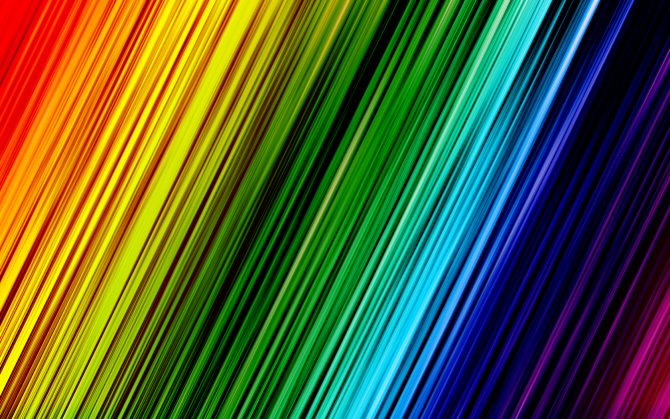11/17/2018 About Sleep
According to statistics, at least 18% of people see colored dreams, and another 63% are not sure whether their dreams are colored. Even with modern technology, there is still no way to verify whether night visions are actually colored or whether they are presented in black and white. But then it turns out that the respondents described not what they saw, but their perception of the color scheme on a subconscious level.
The nature of dreams

Dreams are the result of the active work of the cerebral hemispheres during a person’s night rest. They are inextricably linked with reality and come at moments of strong experiences, emotional outbursts, and are the result of hidden desires. The stronger the emotions and excitement experienced in reality, the more emotional and colorful the dreams will be.
Most often, colored dreams are presented in dark shades and have a negative connotation. This is due to the fact that negative emotions prevail over positive ones - they disturb the sleeper for a long time. Subconsciously, a person tries to solve a real problem in a dream and sometimes it succeeds - even if he cannot remember what exactly he dreamed about at night, the solution is reliably stored in memory.
Color dreams come in the fast-wave rest phase, when the body is psychologically unloaded. The sleeper may not remember this, but during the night he sees several different dreams with a period of one and a half hours, which corresponds to the cyclical nature of sleep. Usually, moments from the last dream remain in the memory after waking up.
External conditions also affect night visions. So, for example, if a person dreams that he unbearably wants to go to the toilet and cannot find it, then there is a high probability that he really should wake up and visit the restroom. People who fall asleep to music, a TV series or a movie see their echoes in their dreams, as the hearing organs continue to receive the information entering them.
Nature of sleep
When a person plunges into the kingdom of Morpheus, consciousness recedes into the background and the reins of power pass to our subconscious. And who knows what you can see in a dream as a result of its interweaving with images from external reality.
During the night's rest, daytime information is sorted and processed. Dreams are the result of the work of higher nervous activity. When the brain stops perceiving stimuli from the outside world, it begins to notice what passed by during wakefulness.
Why do I have colorful dreams?

When a person is in the grip of a dream, he first of all pays attention to the emotional coloring of what is happening, analyzes his feelings and experiences. Then you have to connect events that replace each other and often do not obey logic. It is not surprising that the dreamer does not pay attention to color, so he says that he had a dream in black and white.
The color composition of dreams will be stored in memory if at least one of two conditions is met.
- Focusing on color
If during the dreaming process the sleeper turns his attention to the color of a particular object or object, then this moment will remain in memory even after waking up. Most often, people remember a bright blue sky, muddy green water, and simpler objects - a red dress, a green apple.
- Emotional color
The color perception of reality is deposited in the subconscious from childhood. For example, a red traffic light is associated with prohibition and danger, and a green one is associated with calm and the illusion of protection. The mechanisms of symbolism continue to operate in dreams. For this reason, emotional experiences cause colorful, vivid dreams. In nightmares, the colors most often predominate are black and red, while in good visions, green, yellow and blue predominate.
When do you have memorable vivid dreams and how much sleep?
Many people have memorable, vivid dreams , wondering, for example, why they dream of mushrooms during the day. The answer is here - www.sonnik-online.net/ . Then, when do such dreams occur, and why do we often fail to remember them? And is it possible to find out how much sleep you need, how to remember dreams?
Without touching on mystical explanations, which will be discussed at the end, we will touch on scientific views on the mechanisms of sleep.
Of the five stages of sleep, the most important stage is the fifth (REM) and the fourth stage during REM sleep, when vivid dreams begin, about six hours after the onset of sleep.
After easing yourself through deep sleep, brain activity returns to the Theta (4-8 Hz) range with Beta (12-38 Hz) rapid eye movement, which scientists say represents the dream phase. If you suddenly wake up at this stage of sleep and quickly fall asleep, then, scientists say, it is even possible sometimes to return to the same dream. This stage of REM sleep is important for healthy brain function for many reasons, including the creation of long-term memories. Lucid dreams also occur at very high frequencies of 38-90 Hz, marking a very active state of the brain.
Dreams also occur in the fourth, preceding the fifth (REM) stage. Dreams are more easily remembered when waking up naturally, rather than when an alarm clock or other irritating factor sounds. In order for the dream to be remembered better, you do not need to move and try to gently fall back into sleep.
The greatest chances of having a vivid dream occur in the morning. It is clear that in order to dream more often, you need to sleep at least six hours. The latest data on the human need for sleep no longer fit into the primitive concept of the need to “sort out information into shelves.” The question is deeper and more complex, but this is not discussed in this article; in any case, there should be five cycles in the duration of sleep. But this is not five hours, but precisely five cycles, each of which is 90 minutes. And this is a little less than eight hours.
READ ALSO: People who speak two languages have more gray matter in their brains
If we sleep for 7 hours, then we wake up somewhere in the middle of the fifth stage of sleep, and if less, then we do not reach a vivid sleep. As you can see, unexpectedly, from the point of view of the necessary vivid dreams, we received the minimum duration of sleep that a person should have. Then let’s compare how much we began to sleep with the advent of the Internet, computers and tablets, and mobile phones. Scientists say the more chances we have to sleep, the better. If this is a vacation abroad, then most likely this is not only a regular vacation, but also even more sleep without the Internet, since mobile roaming is unaffordable for most.
And what can you do so that your dreams are not interrupted and are easier to remember when the alarm clock interrupts them? There is only one way out - go to bed earlier. But what then to do with your favorite VKontakte, Odnoklassniki and the Internet in general? Many live with this at work, during lunch breaks, and during smoking breaks. This is confirmed by reports on site visits. It is on weekdays that there is a surge in visits, and on weekends there is a minimum of visits. Otherwise, it is difficult to stay healthy and well-rested in this world. Hence the demand for mobile Internet and tablets, wireless access to the global network.
But we digress. Does everyone need the same number of sleep cycles? No, they say, scientists.
People are different, and age has its own characteristics. Therefore, the following is recommended for different age groups.
- Newborns - Up to 18 hours or 12 sleep cycles;
- Infants 1-12 months - 14-18 hours or 9-12 sleep cycles;
- Children 1-3 years old - 12-15 hours or 8-10 sleep cycles;
- Children 3-5 years old - 11-13 hours or 7-8 sleep cycles;
- Children 5-12 years old - 9-11 hours or 6-7 sleep cycles;
- Teenagers - 9-10 hours or 6 sleep cycles;
- Adults - 7-8 hours or 4-5 sleep cycles;
READ ALSO: Woodworking machines from FDB Maschinen
Pregnant women - 8+ hours or 5+ sleep cycles (plus additional sleep time).
Brain scans show that REM sleep also occurs at the end of the first sleep cycle and lasts only a few minutes. Much of the first cycle is devoted to slow-wave sleep, necessitated by the need for physical rest. These are usually fleeting dreams and daydreams that are barely remembered and are unlikely to result in lucid dreaming.
When we sleep through the night, our phases become longer in each sleep cycle. By morning, our fourth or fifth sleep cycle may produce 45 to 60 minutes of uninterrupted REM sleep. This is ideal for lucid dreaming.
- And the 1st stage of sleep marks the loss of self-awareness and attachment to the physical world. Many claim that during sleep the soul wanders in another world, or in other dimensions.
- The second stage is dreamless sleep with loss of muscle tone with bursts of brain activity in the Beta range at frequencies of 12-16 Hz.
- The third is the stage of deep or slow sleep at a frequency of only 0.5-4 Hz. When we wake up during it, we will feel lethargic and overwhelmed, and for several minutes we cannot come to our senses.
This is how we learned when vivid dreams occur, when they are remembered, and how much sleep you need. (Copying material without an active hyperlink to the source is prohibited.)
Material on the topic: Healthy human sleep remains in a test tube, but 12 rules of sleep and a mattress will help. If the article is interesting, click on the social media buttons to let others know about it. Subscribe.
Who sees colorful dreams
In search of an answer to the question of who dreams in color, scientists have hypothesized that every person’s dream has a certain color scheme that matches the real world. This is logical, since during wakefulness, normal color perception occurs in colorful tones. But then another question arises - which sleepers remember colors in night visions and which do not?
Effect of age
According to surveys, most young people have brightly colored dreams, while the older generation has dull nighttime episodes. Perhaps this is due to the fact that with age a person becomes less emotional, so gray everyday life is transferred to night visions.
Young people strive to receive new emotions and impressions; their brains use many neural connections. Therefore, colored dreams are a common occurrence for them. This means that children have the brightest vision, since for them color has a special meaning in understanding the world around them.
The influence of intelligence
The higher a person’s brain activity, the more neural connections are involved in his life. Neurons remember information, impressions are stored in them. When a person has a well-developed intellect, he easily recalls various facts and events hidden in the distant corners of his memory. For others, these neural connections remain inaccessible and represent forgotten memories that are actually stored in memory.
The activity of neurons in people with well-developed intellect causes the appearance of colorful dreams. Sleepers often see important moments from the past and experience the same events.
Creative development
It is no secret that the works of Salvador Dali are a reflection of his dreams with all the bright colors that were used to paint the canvases. Creative people are receptive to the changing realities of reality and experience them deeply. They perceive the world not from a logical point of view, but on an emotional level, so their night visions are bright and colorful. Many brilliant creative works of various authors in various fields of art are the result of successful dreams.
Psychological disorders
American scientists conducted a large-scale study, during which all patients were divided into three groups:
- Schizophrenics;
- Healthy people;
- Patients with various phobias.
It turned out that a healthy person experiences colorful dreams about 20 times less often than subjects with abnormalities. Many people encounter their phobias in their dreams. Dreams that carry emotional negativity have a bright color.
Scientists' opinions
Previously, it was believed that only patients with schizophrenia were able to see dreams in colors. To date, research has proven this statement to be untenable. Yes, there is a fact that schizophrenics are 20 times more likely to see colored dreams. But there are also quite normal people who note this feature.
So, who dreams in color? Some researchers and scientists believe that television and photography have influenced the perception of dreams. After all, at the very beginning they were black and white. So, according to researchers, people who lived at the beginning of the 20th century more often had just such dreams.
Scientists who study sleep processes (somnologists) believe that a person perceives only the images that he sees at night. But he doesn’t pay attention to the color and details of the dream. During the transition to wakefulness, a person begins to remember everything and subconsciously thinks up some images, emotions, and even colors pictures. But this is not always exactly what happens.

The meaning of colored dreams

Psychologists and somnologists from different countries have long been conducting research on the topic of dream colors, and have identified a pattern, determining the meaning of certain shades for the sleeper:
- Red often symbolizes anxiety, danger, and alertness. Less often it is a sign of falling in love.
- Orange is a sign that a person needs rest. High workload causes unreasonable anxiety, which is expressed by the orange palette.
- White - a positive color of vision indicates readiness for new achievements, good mood and general emotional tone of the body.
- Light colors mean calm and serenity.
- Blue – a positive mood, accompanied by a desire to isolate oneself from the outside world. Most often it appears when a person is doing well in life, but lacks time for himself.
- Golden speaks of a high degree of tension - a “fasting” day is needed both emotionally and physically.
For some people, certain colors have their own meaning. For example, women interviewed focus on the fact that before the start of the menstrual cycle they dream of a red object - and this is an unmistakable sign that has never misfired.
The meaning of color in a dream
To correctly interpret the images, it is necessary to take into account the specific meaning of color in a dream . Remember which shades predominated and refer to the following information for interpretation:
- The color purple speaks of the desire to free yourself, to break down barriers that exist only in the head. This is a sign that a person is about to have an insight that will completely change his life. In addition, the image hints at the emerging truth, understanding, and the fight against deception. Purple also indicates creativity, inspiration and new discoveries. In the near future, something unusual and wonderful awaits the dreamer.
- Blue is the personification of spiritual qualities. Often it hints at kindness, happiness and sincere feelings. Other details of the dream will help reveal the exact meaning of the color. Sometimes blue shades indicate a desire to get rid of daily worries and difficulties. This may be a sign that a person needs rest, solitude and peace. Perhaps you feel a desire to be alone for at least a little while to think about everything that is happening. This color also represents depth of thought.
- Blue objects also represent positive character traits. This light tone indicates openness, clarity, joy. It may hint at a desire for peace, harmony, and tranquility. Blue hints at taking time for the spiritual component.
- White color embodies innocence and purity. Most often it relates to a person’s thoughts and speaks of inner harmony. It may mean that you are just trying to find peace, or have already been able to achieve it. To accurately interpret night dreams, they take into account whether the white objects were clean or had dirt on them. In this case, the image is associated with bad deeds, internal imbalance, and depression.
- Traditionally, yellow is the color of joy and happiness. This is a shade of the sun that represents summer, warmth, and a new harvest. But when interpreting, they take into account the form in which this tone appeared. For example, autumn leaves rarely mean anything good. They symbolize internal decline, sadness, longing for the past. This image may hint at mental anguish and torment, a feeling of hopelessness.
- Green is traditionally the color of renewal and happiness. Green things in visions can indicate hopes and desire for a better life. The origins of the interpretation are related to grass and tree leaves. Green is a symbol of spring and the beginning of a new happy period. The shade may hint that the sleeping person is striving for change. This is a sign of fatigue from the past, a desire to start doing what will make you happy. Green can indicate dissatisfaction with what is happening in the present. In this case, it encourages action. But it is important to take into account what exactly acquired an emerald tone in the night plot. If we are talking about green eyes, this is considered a subconscious personification of deception, danger and risk. Perhaps a person will actually encounter unscrupulous people.
- The red tone is associated with pleasure, passion, strong feelings and emotions. The presence of objects of this color in a dream indicates the unbridled nature of the dreamer, that he cannot resist his passions. This is the desire to indulge one's own desires and seek pleasure. Another option for interpreting red things is to desire a luxurious life. This can be indicated by the bright scarlet car that you had in your vision. If red flowers appeared and you presented them as a gift, this may be a hint of the strong feelings that you actually experience.
- Black is traditionally interpreted as a symbol of grief, depression, misfortune or trouble. In the dark, secrets are hidden from a person that cannot be solved without bright light. And the unknown often warns of risk and danger. We can talk about internal disagreements, imbalance, lack of peace. Often black objects are a reflection of the depression into which a sleeping person plunges. This is a sign of despair, suppressed emotions, unfulfilled ambitions. The color may hint at a longing for the past.
- Pink and pastel shades are the personification of naivety, inner purity, and sublime feelings. But this meaning can intensify, and in this case it will indicate infantility, being in a fictional world, and lack of connection with reality. Sometimes the color hints at the desire to live a simple life, devoid of difficulties and problems. The person who dreams about it is not attracted to complex goals. He craves ease in life. True, this leads to a lack of responsibility and a desire to shift responsibilities to other people. Daydreaming, which is characteristic of a person, alienates him from reality. It is necessary to find a balance between internal desires and external circumstances. It is impossible to constantly live in your own fantasies.
More on the topic: Which part of the brain is responsible for sleep
Disease or benefit?
The fact that colored dreams are an integral sign of schizophrenia can frighten impressionable people. This, by the way, will lead to the appearance of new colored dreams and the “circle” will close. In fact, colored dreams come to all people at least once in their lives, except those who are blind from birth and have never seen all the colors of the world. The frequency and intensity of dreams depends on the characteristics of an individual person.
In addition, schizophrenics usually see nightmares in their dreams - ghosts, monsters, blood. If a healthy person does not have any of this, then there is no point in worrying about the psychological state. Moreover, vivid night visions help develop extrasensory abilities or require the implementation of creative personality skills. In both cases, they can be used as an impetus for new achievements.
Research by specialists
It was possible to connect the colorfulness of dreams and psychological disorders with the invention of the tomograph. It was at this point that it became clear that unusual brain activity at night is common to all people. But only in patients with phobias and severe psychological disorders does it cause nightmares.
A healthy person does not need to worry even if his usual not vivid dreams are replaced by colorful dreams. To independently search for schizophrenia in yourself, you can pay attention to increased isolation, lack of positive emotions, and indifference to self-realization. If there is none of this, then your psychological health is in order. If you detect at least one sign, you should consult a doctor, since vivid dreams are caused not only by schizophrenia, but also by depression due to stress, which is treatable.
Hypotheses of colorful dreams
Since there is no technology that could clearly answer the question of when and why color and black and white dreams occur and what they symbolize, scientists continue to build various theories and guesses on this matter.
Theory 1. Everyone has different dreams.
It is based on the fact that every person observes both color and black and white dreams, but remembers only those that are accompanied by rich colors. Emotional activity adds color to the imagination, and overwork and chronic fatigue are accompanied by faded dreams that are not deposited in the memory of the sleeper.
Theory 2. Color is a sign of talent
Since bright images most often come to artists, some researchers have concluded that frequent colorful dreams are a sign of talent, including undisclosed talent. True, the same scientists claim that all talented people have a tendency towards schizophrenia, which is why they call the symptom both positive and alarming.
Theory 3. Color cinema
This is a rather dubious hypothesis, since it assumes that the colorfulness of dreams is associated with the advent of color television during the childhood of the new generation, when the perception of color is formed. But according to this same theory, it turns out that the older volunteers studied did not see other colors in life except black and white TV, so the hypothesis refutes itself.
reasons influencing the color of dreams
- emotional condition. Scientists have found that this directly affects not only what kind of dreams we see, but also how they are colored. if a person lives a fulfilling life, does not suffer from depression and enjoys every day, his dreams will reflect all these factors. conversely, if you are tired, your emotional state is far from normal, and you experience a feeling of apathy, then your dreams are likely to be gray and dull.
- creative people see colorful dreams much more often than others. their rich imagination itself contributes to this process. and impressionability and emotionality add color.
- It is also believed that such dreams occur only to people with high intelligence.
- There is an opinion that color dreams are directly related to the age of cinematography. although whether or not to believe in such a fact is a questionable question. Research conducted by scientists has revealed that the younger generation sees vivid dreams more often than people at a more mature age. This is directly related to watching films. and since the older generation had the opportunity to watch only black and white films, conclusions were drawn accordingly.
- psychological condition. Doctors also put forward a hypothesis about who has colorful, vivid dreams. they, according to experts, are a deviation from the normal human condition. which means that if you don’t see black and white dreams, simply put, you have mental problems or you suffer from schizophrenia. This hypothesis appeared after a series of studies by Professor Bravin Stent, but today many scientists refute this theory.
- emotional condition. Scientists have found that this directly affects not only what kind of dreams we see, but also how they are colored. if a person lives a fulfilling life, does not suffer from depression and enjoys every day, his dreams will reflect all these factors. conversely, if you are tired, your emotional state is far from normal, and you experience a feeling of apathy, then your dreams are likely to be gray and dull.
- creative people see colorful dreams much more often than others. their rich imagination itself contributes to this process. and impressionability and emotionality add color.
- It is also believed that such dreams occur only to people with high intelligence.
- There is an opinion that color dreams are directly related to the age of cinematography. although whether or not to believe in such a fact is a questionable question. Research conducted by scientists has revealed that the younger generation sees vivid dreams more often than people at a more mature age. This is directly related to watching films. and since the older generation had the opportunity to watch only black and white films, conclusions were drawn accordingly.
- psychological condition. Doctors also put forward a hypothesis about who has colorful, vivid dreams. they, according to experts, are a deviation from the normal human condition. which means that if you don’t see black and white dreams, simply put, you have mental problems or you suffer from schizophrenia. This hypothesis appeared after a series of studies by Professor Bravin Stent, but today many scientists refute this theory.
and yet our science cannot give an exact answer to the question “why do I always have colored dreams?” there are many guesses and assumptions around this topic, but not one of them has yet been fully proven. some believe that dreams have no color, and they take on colors in your imagination. based on what we want to see. Our subconscious will paint a good dream in bright colors, while a gloomy one will endow it with dark, gray colors. remembering what you dreamed, you involuntarily add bright accents and colors. and by the way, even if you don’t remember that you had a dream last night, this does not mean at all that it is true. a person sees several scenes at once during the night, and he manages to remember only a few of them.
After interpreting a dream, we wonder when dreams come true. whether the dream will come true or not depends on which lunar day you dreamed about and on what day of the week. Let's look at the lunar calendar - what phase of the moon is today and what lunar day.
By comparing the data on the lunar day and the day of the week, we can guess whether the prophecy of the dream will come true.
Interesting facts about dreams
Several interesting facts about dreams have been established that are indirectly related to the color of night visions:
- Women are very emotional, so vivid dreams are a common occurrence for them;
- The right hemisphere is responsible for the color and meaning of dreams, so left-handers are more likely to talk about what they saw at night than right-handers;
- There are no dreams during snoring;
- Giving up a bad habit is often accompanied by a return to it in colorful dreams;
- When prophetic dreams occur, they are as realistic as possible and painted in bright colors.
The presence of nightly colorful dreams should only cause concern in cases where the content of the dream itself is disturbing. If in dreams a person is transported to a bright and pleasant world, wakes up rested and full of vital energy for new achievements, then such dreams can be enjoyed without hesitation.
Share on social media networks









